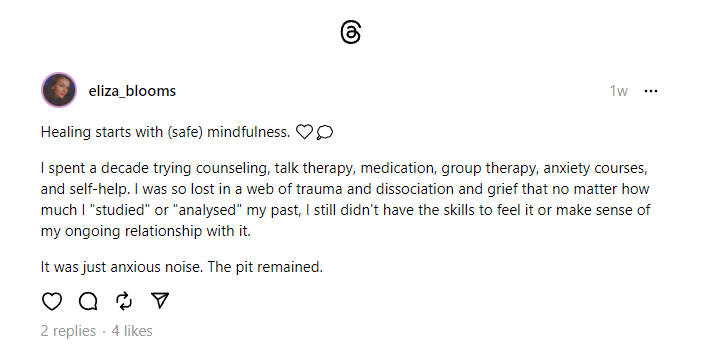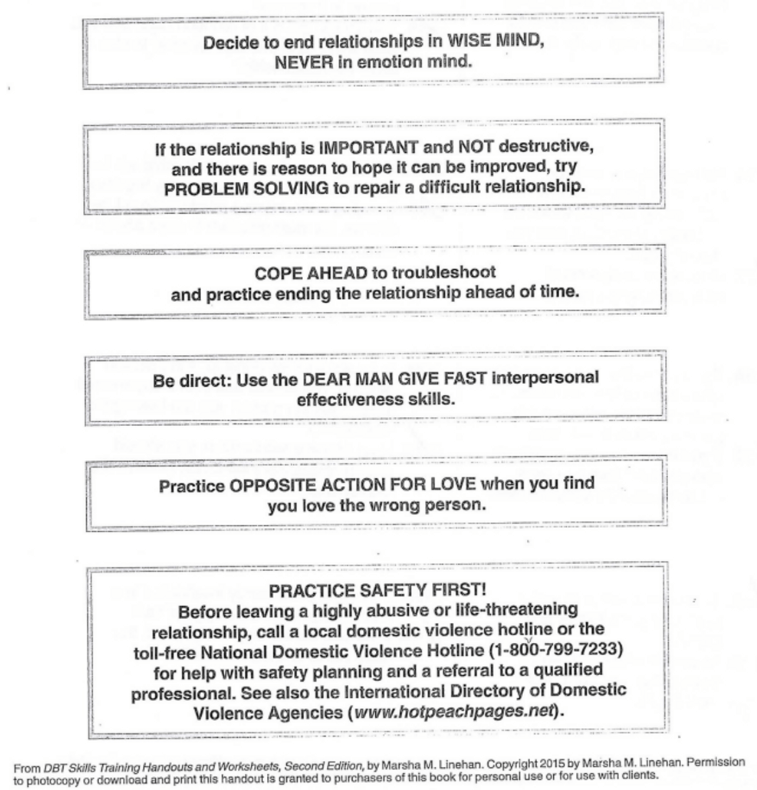
Why Healing Trauma Starts With Creating Safety
Something that I’m only just starting to realise, after struggling to “fix” myself for over 10 years with no success, is just how instrumental physical and emotional safety actually are to healing.
We’ve all heard the phrase “You can’t heal in the same place that hurt you.”
But how do we apply that expression to trauma?
Simply put: you can’t heal in the same environment that traumatised you.
I’ve had a few thoughts about this recently, and, with my past and current experience navigating the healing journey from complex trauma, I thought I’d put some of those thoughts into words.
Please note: as this is a personal account of my experiences with healing, safety, and trauma, there will be mentions of past self-harming behaviours. There is nothing specific, but please give this one a miss if you’re not feeling up to it.
Understanding trauma (and dissociation)

A quick reminder that I can only speak from personal experience here — I can’t speak for everyone.
For me, my experiences with complex trauma meant being stuck in traumatic places and situations that I couldn’t get out of for years at a time, and my body’s way of coping with and protecting me from that was to develop a keen use of dissociation.
I learned to dissociate around the most painful parts of my experiences, which left me with a distorted belief that there was something intrinsically wrong with me and it needed to be fixed.
This led me down a decade long spiral of mental health services, assessments, referrals, and, eventually, a diagnosis, but I still felt no change.
I was completely dissociated from the current trauma occurring in my life, and at the same time I was chasing answers to the traumas of my past in the hopes that they would ‘fix’ it all.
The role of safety in healing trauma
Honestly, for me, I couldn’t heal at all in the environments I was trying so desperately to heal in.
I really had to take some absolutely terrifying leaps of faith to get myself to physical safety.
Getting off the booze, in therapy for my BPD recovery. out of abusive and/or destructive relationships, into a line of work that would get me away from the pub scene—and into my own safe place to finally regain a sense of autonomy, were pretty much the bare foundations of getting my physical safety back.
The rest, which I’ll talk about in some more detail below, came gradually, and is still a work in progress. But it brings me nicely on to my next point.
The role of safety in healing trauma applies to multiple avenues of our lives: from personal physical and emotional safety, to financial, institutional, relational, societal, and spiritual safety.
Now I’m not saying we have to have ‘acquired’ all of these things in order to start our healing journey, but without any of them, we are going to hit huge roadblocks on the way to trauma recovery.
What does the research say?

Trauma and Recovery by Dr Judith Herman is one of the core foundational books when talking about complex trauma and recovery. Dr Herman discusses three stages of trauma treatment in this book.
Based on the individual’s needs, the specific stages may vary, but they serve as a practical and helpful guide for those seeking to overcome the long-term and destructive effects of past traumatic experiences.
In her book, she goes on to say:
“The first, and perhaps most important, stage of trauma recovery is about establishing safety. People affected by trauma tend to feel unsafe in their bodies and in their relationships with others. This stage might last weeks, months or even years, depending on the level of trauma. Everyone’s journey and timeline is different.
This stage is focused on skills development to aid you to practice self-soothing and care skills to increase emotional and behavioural stabilization. This helps you learn ways to manage urges to abuse substances, alcohol and/or self-harm.”
How can we restore safety on a personal, therapeutic, and societal scale?
Creating safety in relationships

Creating safety in relationships is an important part of healing from trauma. One aspect of this is ending destructive relationships that may be contributing to ongoing trauma.
Note: from personal experience, this can be the most monumentally difficult but absolutely necessary step required in order to create a safe and supportive environment for yourself.
Once you end the cycle of harmful relationships in your life, nurturing healthy relationships and healing your trust long-term will be a natural next step—and another challenge within itself.
This will involves learning how to build and maintain positive relationships with others, as well as developing the ability to trust others after experiencing trauma. These are the types of skills taught in the Interpersonal Effectiveness sector of DBT.
Overall, creating safety in relationships is an ongoing process that requires Mindfulness Skills, intentional effort and a willingness to prioritize one’s own well-being—more on this later.
By surrounding oneself with supportive and trustworthy individuals, it becomes possible to create a foundation of safety and security that is essential for healing from trauma.
Marsha Linehan—Creator of Dialectical Behaviour Therapy—offers these skills to help navigate ending destructive relationships:

Creating safety in society

In our journey towards healing trauma, it is crucial to recognise that its effects extend far beyond the individual level.
One thing I’ve learned is that trauma doesn’t occur in a vacuum—it permeates our society, leaving an indelible mark on communities, environments, families, and institutions.
To truly address trauma in a meaningful way, we must prioritize the creation of safe spaces and support systems that work in harmony to foster healing and resilience throughout society.
Some ideas might include:
- Cultivating Empathy and Understanding: By raising awareness about the myriad ways trauma manifests and affects individuals, we can encourage compassion and reduce stigmatization. Education campaigns, public discussions, and media representation can play a vital role in dismantling misconceptions surrounding trauma. When society as a whole is educated on the complexities of trauma, it becomes more supportive, empathetic, and inclusive.
- Breaking the Cycle: Trauma has far-reaching consequences that transcend generations. Addressing trauma on a larger scale necessitates breaking the cycle, preventing its recurrence, and interrupting intergenerational trauma. By investing in mental health services, accessible therapy, and trauma-informed care, we can equip future generations with the tools they need to navigate life’s challenges safely and resiliently.
- Creating Safe Communities: Communities should be nurturing spaces where all individuals can feel safe, supported, and respected. Prioritizing community initiatives that promote inclusivity, diversity, and belonging helps to create a strong foundation of safety for all members and work to end ongoing institutional trauma for minority communities.
Creating safety in therapy settings
Safety is essential in therapeutic settings because it gives us somewhere that we can build enough trust to open up and potentially explore traumas. A lack of safety can cause individuals to become resistant or even retraumatized by the therapy process.
For me, I had tried to do DIY ‘trauma work’ a lot over the years, with no guidance or emotional regulation skills to handle it, or for it to be effective. This mostly led to me crying in a heap on the floor, having a panic attack, and harming myself—and making notes on perceived insights in the aftermath.
It wasn’t until I had a safe therapeutic environment and the basics of DBT skills (Mindfulness, Emotional Regulation, Distress Tolerance and Interpersonal Effectiveness) down that I could actually start to piece together and understand my relationship to the complex trauma of my past in a safe way.
I had to actively learn new skills to start reducing my dissociation around certain parts of things, and practice this day-in, day-out. A safe therapeutic environment gave me three guaranteed safe hours every week to do this.
While I’m no therapist, to create a safe therapeutic environment, therapists can start to build more trust with their clients, establish clear boundaries, and ensure (where possible) that clients have a safe support system outside of therapy. It’s also important to customize treatment plans to fit each individual’s unique needs and to regularly check in and adjust accordingly.
Creating safety on a personal level
Obviously, creating safety on a personal level is one of the most critical and powerful ways to restore a sense of safety after trauma—but there’s a reason I’ve left this until last.
It can be incredibly difficult to establish safety on a personal level when you don’t have safety in your relationships, society, or therapeutic spaces. Therefore, I didn’t want to gaslight anyone by bombarding you with self-help advice before we address all of that.
I know that I didn’t have a hope in hell of developing any of these skills when I was still in unsafe environments, but once I had established those initial parameters of physical safety, I was slowly able to work on creating safety from within.
These were all essential components to creating a sense of safety within myself, and establishing an unshakeable foundation for healing and growth:
- Identifying personal safety needs: To even begin this, I have had to practice my mindfulness over and over. Identify what safety looks and feels like to me, and recognising my own needs (and where they weren’t being met) in order to be and feel safe.
- Establishing boundaries and self-compassion: To create a sense of safety within yourself, you must also learn how to develop boundaries with others. My greatest tip here is to set boundaries with the expectation you will have to remind people of them, but remember my safety in relationships advice from earlier for frequent oversteps.
- Learning to express myself authentically: Mindfulness and journaling as a daily practice helped me to clearly identify and express my thoughts, feelings, and needs. For this I found BPD journal prompts extremely useful for getting started.
- Reparenting & inner child work: Addressing childhood trauma and early childhood experiences, allowing myself to re-find and re-experience my joy without being subject to traumatic situations.
- Safety affirmations: I’ve always been a big believer in affirmations—but they have to align with the truth. So once you have found that place of safety, acknowledge that. Write it. Speak it. Over and over until your brain starts to truly believe it.

Read More: Journaling For Mental Health: The Ultimate Guide
Feeling safe after trauma
To feel safe after trauma, you need to first of all restore safety. Please don’t stay stuck in situations where you are physically or emotionally unsafe and villainising yourself instead of taking the steps to end destructive relationships.
Develop physical safety by making environmental changes, seek emotional stability and regulation skills through therapy and mindfulness practices, establish boundaries, cultivate trusting relationships, and engage in self-expression for a holistic approach.
If you have developed safety, it may well take a while for your body and subconscious to catch up to this. My biggest problem with feeling safe in the early stages of finally being safe really came down to not trusting myself to keep myself safe.
So setting boundaries, building my discernment and at the same time challenging internal assumptions and judgments of danger with DBT Mindfulness Skills became the most crucial part of rebuilding self-trust.
How to feel safe after trauma FAQs
Why does trauma make you feel unsafe?
Trauma, however complex, can result in repeated episodes of mental or emotional flashbacks, impacting physical, emotional, and psychological well-being. This means the sympathetic nervous system can fire even without the presence of a threat, preparing us for fight, flight, freeze or fawn.
This can make it feel incredibly difficult to get back to (and maintain) a stable sense of safety as a trauma survivor. it is absolutely not impossible. I am living proof of that. Give it time and keep going with your recovery, but I see you and how difficult this journey is. You’re not alone in this.
How do you develop a sense of safety after trauma?
If safety is restored–which mindfulness and objective awareness can help you decipher–then it comes down to learning new emotional regulation skills, distress tolerance skills, and, most importantly, giving it time.
You can help nudge yourself in the right direction by “doing the work” with DBT, online therapy, or whatever therapeutic methods you have access to, but however you keep pushing towards recovery, over time the changes in your felt sense of safety will catch up.
I never thought I would feel happiness as a baseline again. And now, after a few years of tough recovery decisions and patience with my body’s healing journey, I can’t imagine not living my life with happiness as a baseline anymore. Please, hold on to hope. You can absolutely rebuild safety in your body after trauma, and time will help you feel this.
How do you start feeling safe in your own body healing trauma?
As we know by now, the Body Keeps the Score, and dissociation can be a pattern developed to protect us from that feeling of danger in our bodies after trauma. From my own experience, it is hard to feel safe again in your body after trauma, and it can feel easier to avoid feeling anything at all.
Mindfulness was key for me to reconnect to my body, but as I touched on earlier in this exploration, I had to find a safe therapeutic environment to learn and practice this mindfulness around my trauma. Then I just had to keep practicing.
For me, another key aspect of feeling safe in my own body after complex trauma, was movement. Somatic healing practices—for me mainly dancing, deep hip work, and yoga, or a wild mix of the three—are a serious wonder for rewiring our connection to the body.
A holistic approach would also recommend bringing a focus back to your physical well-being through exercise, nutrition, and adequate sleep. Mindfulness practices help ground yourself in the present moment, fostering a connection between your body and mind and the Now, and only observing the facts of the moment through your senses. This can help bring you back to the present moment, helping in moments of dissociation or emotional flashbacks.
If you’re spiritually inclined, working on healing the lower chakras for trauma healing can be extremely powerful.
- Bring it back to the Root: Are you safe? Can you check the facts and notice any assumptions or judgments?
- To the Sacral: Do you feel loved? Do you feel safe?
- And to the Solar Plexus: Do you and your circle act with safety and love?
If you find affirmations useful, you can approach them in a slightly different way to ensure they are trauma-informed. Try “Physical and emotional safety exists.” “I deserve to be and feel safe.” “I want to be and feel safe.” “I am worthy of both physical and emotional safety.”
Final thoughts on why healing trauma starts with restoring safety
Creating safety, and a felt sense of safety, after trauma is not always easy work, but it is incredibly powerful work. Remember that you are strong and capable, and that you deserve to experience safety in your life. It might take a bit of time, but it is possible to rebuild your relationship with safety—and yourself—from the ground up.
Keep up with me over on Threads or Instagram. It’s always a safe space for recovery in my community!
You Might Like: The Little Guide To DBT Mindfulness Skills

This 30 page digital e-book includes:
- 6 DBT Mindfulness Skill Graphics with easy-to-understand visual designs that help you remember them.
- 20+ Mindfulness Skill Journal Prompts with my own real-life example journal entries for each skill.
- Full page journal templates to help you easily combine and learn how to use the skills.
- Personal insights from someone who truly had their life saved by DBT – and how I went from zero DBT skills to daily skills use.
Available for instant download now

Healing trauma & safety FAQs
How do you restore safety after trauma?
Restoring safety after trauma can be a complex process, but it starts with creating physical and emotional safety in your life. This includes boundaries, self-compassion, and cultivating trusting relationships with yourself and others. It is also important to find therapeutic interventions that work for you.
What are the phases healing trauma?
According to Judith Lewis Herman, the three phases of trauma treatment are: safety and stabilization, remembrance and mourning, and reconnection and integration. Together, these phases provide a therapeutic framework for trauma recovery and healing.
How do you process trauma safely?
Processing trauma safely depends on the individual and their specific needs. It is important to find a skilled therapist that can help you learn effective coping strategies and provide an emotionally safe environment for processing your trauma. Additionally, self-care practices such as mindfulness, journaling, and expressive arts can be helpful in managing symptoms of trauma.






8 thoughts on “Why Healing Trauma Starts With Creating Safety (& How to Feel Safe Again)”